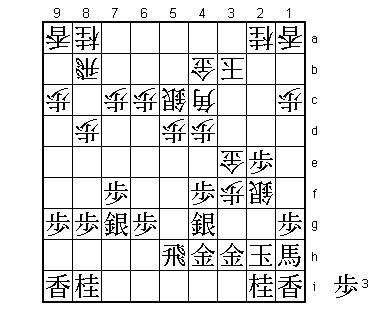
 |
| Diagram 1 |
In the position in Diagram 1, we are about to enter the full-scale war of the endgame. Which side stands better? It's a difficult position to judge. As White, I have forced back Black's promoted bishop and my pieces are more actively placed. On the other hand, it looks as if the pawn on 3f, the vanguard of my aggressive position, might immediately be taken. I also have to consider the potential difference in strength between Black's promoted bishop and White's bishop. If things quieten down, it is highly likely that this difference will make itself felt. White is going to be in trouble if his aggressively posted pieces are removed, so this is what Black is trying to achieve. My only option, therefore, is to seize the moment and press home my attack.
After 14 minutes' thought, I played ... Bx2e. The game continued P*2g P-3g+; Nx3g Sx3g+ (Diagram 2).
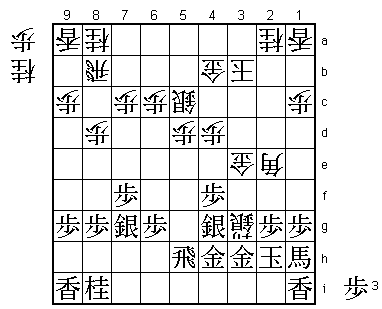 |
| Diagram 2 |
Here Manabe 7-dan played G4hx3g, but he could also have taken with the gold on 3h. After G3hx3g, I was intending ... P*3f; G3g-3h N*5e; S*2f Nx4g+; G4hx4g S*3g; Sx3g Px3g+; G3hx3g (Diagram A).
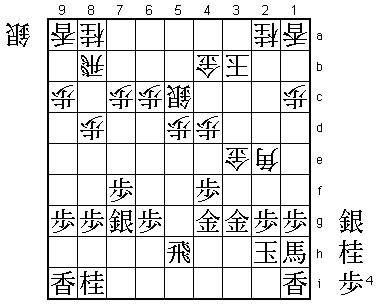 |
| Diagram A |
This is also a difficult position. Since P*3f would put an end to White's attack, he has no time to lose. I would have played ... P-4e; Px4e N-3c. It is not easy to judge this variation compared with the game continuation. In either case, White has no choice but to forge ahead with his attack, though of course this had been my intention.
From Diagram 2, play continued G4hx3g P*3f; G-2f Gx2f; Px2f G*3g; Gx3g Px3g+; Kx3g Bx4g+ Kx4g N*3e (Diagram 3). This is a long but completely forced sequence. If Black now plays K-5g, White wins with ... G*4g; K-6h Gx5h; Kx5h R*3h, etc. Black therefore answered ... N*3e with K-3f, leading into another one-way street.
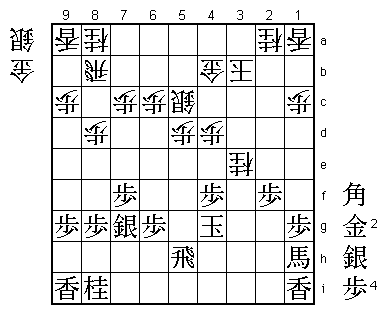 |
| Diagram 3 |
From Diagram 3, the game continued ... S*4g; Kx3e G-3c (Diagram 4). Instead of ... G-3c, I could have taken the rook first with ... Sx5h=, but this enables Black to fortify the head of his king with G*3d, a gold that would be effective in attack as well as defense. White would reply with ... G*3c to get rid of the gold on 3d, but this would lead to a repetition of moves, which did not interest me. I therefore decided to play ... G-3c rather than take the rook. This is the kind of move I like to play; it is the quickest way of forcing the issue, even at the risk of losing the game.
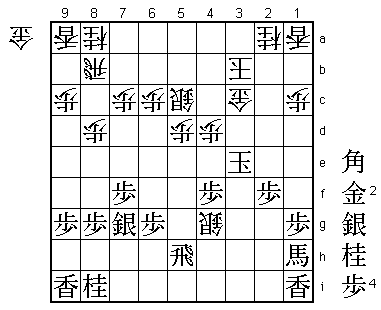 |
| Diagram 4 |
In Diagram 4, Black defended with S*2e and, after ... P-4e; Px4e I finally took the rook with ... Sx5h= (Diagram 5) The interpolated moves G-3c and P-4e show close attention to detail. They have the effect of making the White king's escape route much narrower.
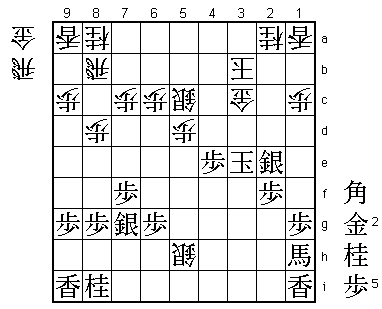 |
| Diagram 5 |
In this position, White has two aims. The first is the rook drop ... R*3h. If then P*3f G*4d; Px4d Sx4d; K-4f R-4h+ (Diagram B) and mates. The second is ... S-4d; Px4d Gx4d; Kx4d R-4b. This does not lead immediately to forced mate, but it is effective in certain lines. The foundations for these two lines were laid by the moves G-3c and P-4e.
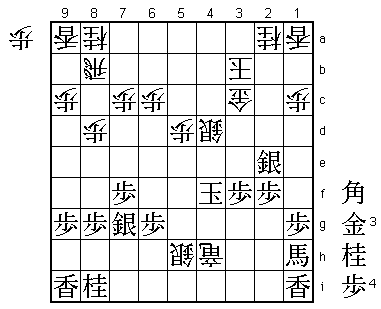 |
| Diagram B |
I replied ... R*5f (Diagram 6).
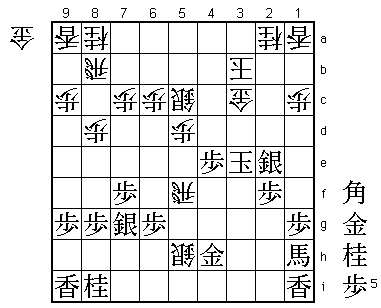 |
| Diagram 6 |
In this kind of position where the two kings are close to each other, a single move tends to have a very high value. A move that simultaneously attacks the opponent's king and defends one's own king is particularly strong in this kind of situation. ... R*5f is such a high-quality move, both threatening mate and defending the silver on 5h.
In Diagram 6, Manabe 7-dan defended against the mate threat with G*4f and I went for broke with ... S-4d (Diagram 7).
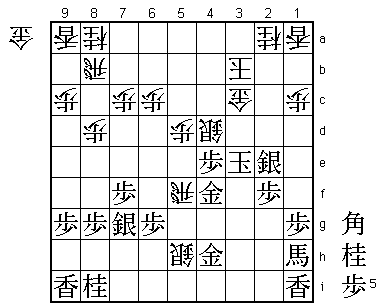 |
| Diagram 7 |
So I decided on the exceptional measure ... S-4d. After Px4d Gx4d; Kx4d Rx4f; K-3e Rx4h+ we reached the position in Diagram 8. If, instead of K-3e, Black interposes on 4e in reply to ... Rx4f, White can simultaneously attack and shore up his own king with ... G*3c, and Black's promoted bishop can no longer enter the fray with +Bx5d.
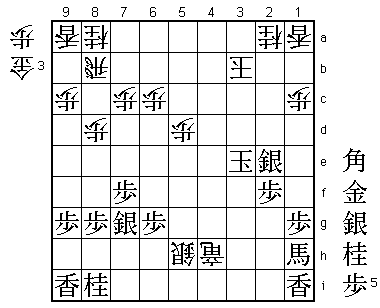 |
| Diagram 8 |
Manabe 7-dan therefore played K-3e and I took the gold with ... Rx4h+ (Diagram 8).
I had envisaged this position when I played ... S-4d, but it was quite unclear to me. Although I didn't really know what was going on, S-4d seemed to be the only way to proceed, so I decided to play it and leave my fate in the lap of the gods.
Here Manabe 7-dan fell into deep thought, taking 51 minutes on his next move. During that time I looked at various lines but still could not reach any definite conclusion. In the post-mortem we focused on this position but found no light at the end of the tunnel. The situation is so unclear that we had absolutely no idea who was winning.
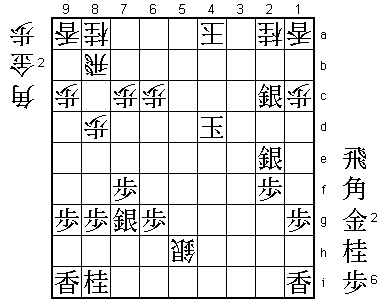 |
| Diagram C |
B*3c; K-3e G*4e; Kx4e R-4b; K-5d G*6d; K-5c B-4d (Diagram D) is also a forced mate. Actually, since I had seen this clean mate, I had a positive gut feeling that the position was winning for me.
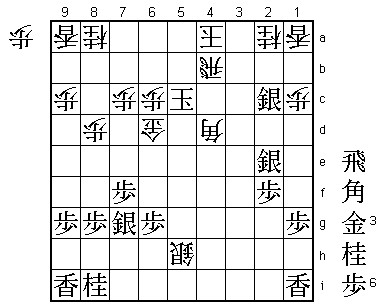 |
| Diagram D |
B*3c was possible in Diagram C because Black dropped a silver on 2c. So how about G*2c instead? After ... Kx2c; S-3d K-3b; +Bx5d K-4a we reach a difficult position (Diagram E). If Black were able to play N*5c K-5a; G*6a here, this would be a fine line for him, but unfortunately he used his gold when he played G*2c. Note the subtle difference in White's response depending on whether Black drops a silver or gold on 2c. It really is quite mysterious how just a very slight difference can change everything in the endgame.
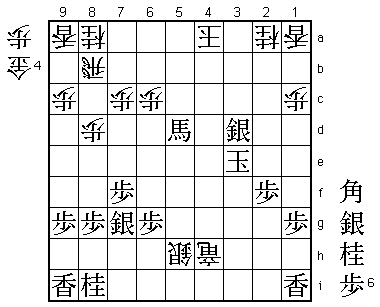 |
| Diagram E |
Returning to the game, play from Diagram 8 continued +Bx5d G*4c; N*2d (Diagram 9).
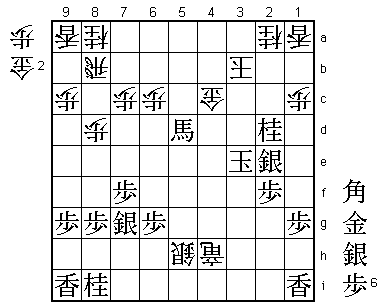 |
| Diagram 9 |
N*2d was the losing move. If White's king runs away with ... K-4a, Black can play S*3b and take the gold on 4c next move. In response to my ... K-4b, Black played B*7e, forking king and promoted rook.
At first sight, it may look as if my blood must have suddenly run cold, but White is actually okay after K-5a (Diagram 10). Black can take the promoted rook on 4h, but White can capture the promoted bishop on 5d in return.
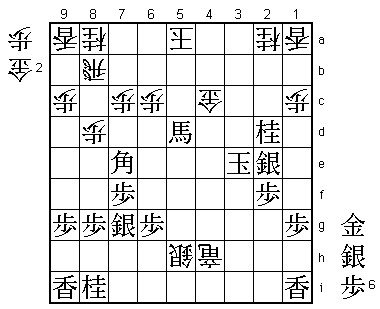 |
| Diagram 10 |
If now Bx4h Gx5d and the win is quite straightforward for White.
Instead of N*2d, the line I was most afraid of was P*3c Nx3c; G*2c. If now ... Kx2c, B*3d decisively forces White back. I would therefore have had no choice but to escape with ... K-4b, but what if Black had then played B*7e K-5a; Bx4h Gx5d (Diagram F)?
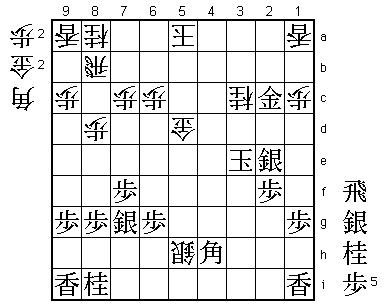 |
| Diagram F |
This capture of promoted rook and promoted bishop may seem the same as in Diagram 10, but actually it is quite different now. For example, in Diagram F, it is difficult to find a good reply to the simple check N*4c. After ... K-6b (if ... K-6a; R*5a followed by capturing the gold on 5d), the sideways movement of the rook on 8b is blocked and Black could go for an entering king with Gx3c, etc. The biggest reason why N*2d was the losing move is that it cut off White's king's escape route via 2d to 2c.
All we could conclude during the post-mortem was that P*3c followed by G*2c was probably the only way Black could stay in the game. Once he had missed this chance, I was always one move ahead.
Even now I cannot fathom what is going on in the position in Diagram 8, but the good judgment I showed in deciding to leap into a difficult and unclear position seems to have led to a winning rhythm.
To be honest, I thought I probably stood a little worse at the point where I jumped in with ... Bx2e. This made the decision easier. If I had thought I was even slightly better in that position, I wonder whether I could have plunged into such murky waters. But if I had gone against the flow and chosen a different path, the result might well have been much worse.